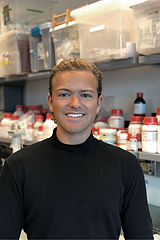Meet some of the 2020 recipients of Canada’s most prestigious graduate awards, exemplifying academic excellence across the full range of disciplines.
 Heather Anderson, Anthropology
Heather Anderson, Anthropology
Space for Listening: An Ethnography of the Australian Radio Quiet Zone.
My doctoral research is an ethnography of the Australian Radio Quiet Zone (ARQZ)—a place where radio bandwidth use is restricted to facilitate the detection of cosmic phenomena by radio-astronomy infrastructure. I interrogate the relationship between this astronomical “listening” and the settler-colonial landscape in which it takes place. I am also attentive to the ARQZ as a space for other modes and practices of listening: of Traditional Owners to Country, of pastoralists to landscape, and of scientists to local communities.
(Photo courtesy of: Simon Kessler)
 Mahmoud Assran, Electrical and Computer Engineering
Mahmoud Assran, Electrical and Computer Engineering
Co-Supervised Learning Algorithms.
Many learning frameworks in the field of Artificial Intelligence (AI) appear to be incomplete, and independently insufficient, for modelling the gamut of human learning potential. A lot of my work with youth on education has inspired my research and approach to improving learning algorithms, and better modelling the salient factors necessary for producing intelligent agents. Building on related work in education such as Social Cognitive Theory and Social Development Theory, I believe that part of the missing piece is social context and diversity.
In my PhD research, I will explore multi-agent approaches for building social context and diversity into learning algorithms. A diverse set of AI agents that learn from independent experience while simultaneously learning to communicate with one another may be able to learn more efficiently (with less time, energy, and data) than single-agent frameworks, and maybe be able to derive more robust representations relating to semantic concepts in data.
 Émile Brisson-Curadeau, Natural Resource Sciences
Émile Brisson-Curadeau, Natural Resource Sciences
Impact of Extreme Climatic Events on the Foraging Behaviour and Breeding Success of the King Penguin.
Extreme climatic events such as El Niño have strong effects on Antarctic Ocean wildlife, effecting changes in the distribution and abundance of the primary producers that reverberate to the top of the food chain. Monitoring effects on top predators could therefore provide information on the density and distribution of a range of prey, especially if their foraging behaviour and population dynamics are good indicators of the population dynamics of lower trophic levels. The king penguin is a good candidate for being an indicator species in the Antarctic Ocean. My research consists of examining how the consequences of climatic extremes on the food web affect the breeding success and foraging behaviour of king penguins. My research will determine the mechanisms between extreme climatic events, wildlife distribution and fitness, which will help in the design of protected areas that consider the spatial responses of predator-prey relationships to these events
 Kyla Brophy, Educational and Counselling Psychology
Kyla Brophy, Educational and Counselling Psychology
Self-Compassion and Emotion Regulation: Deciphering the Pathways to Well-Being.
My research investigates factors that support well-being and resilience during challenging life periods, particularly self-compassion. People who are more self-compassionate report lower levels of stress, increased well-being, enhanced creativity, and greater motivation to pursue their goals. These results have been observed in people of different ages, genders, sexual orientations, and cultural backgrounds. Learning to be more self-compassionate has great potential to support mental health, but more research is needed to understand how self-compassion functions in order to develop effective interventions. My dissertation examines the relationship between self-compassion and emotion regulation, and how self-compassion may help individuals experience and respond to difficult emotions. Results will provide empirical insight into the pathways through which self-compassion impacts distress and well-being, and how different emotion regulation competencies influence these pathways. This work will contribute to developing effective interventions (e.g., workshops, mobile apps) for use by social service providers, educators, mental health professionals, and the public. (Photo courtesy of: Tanner Zekonic)
 Durbis Castillo Pazos, Chemistry
Durbis Castillo Pazos, Chemistry
Shedding light on chemistry: Delivering better and cheaper therapeutics through light-assisted reactions
The construction of new molecules is as complicated as the construction of a bridge: Every piece is meticulously placed, and the overall arrangement of the pieces gives a unique structure, stability, and function. Once a bridge is built, however, making selective modifications that could improve the overall stability and structure are complicated to achieve. In synthetic organic chemistry, such modifications performed to a complex molecular architecture is known as late-stage functionalization, a strategy that is crucial in the development of new compounds with pharmaceutical applications. Nowadays, this strategy relies on the use of expensive and non-recyclable metal-based catalysts and additives. These caveats can be addressed by photochemistry, where a light source, such as a lightbulb or LEDs, can be used as a greener alternative. I herein propose the use of visible light to enable the late-stage functionalization of complex molecular architectures, ultimately aiming for the installation of fluorine atoms, which remains a frontier in the world of synthetic chemistry. This project will enable a cost-effective construction of elusive molecules that will help advance the development of drug discovery. (Photo courtesy of: Rodrigo Mendoza/ Eva Macaluso)
 Maria Ceballos-Bedoya, Law
Maria Ceballos-Bedoya, Law
Women’s Place(s): A Socio-Legal Analysis of Gender Inequalities in the Colombian Judiciary
In many countries, an increasing number of women are deciding to become lawyers, but they are rarely found occupying the best judicial positions. Colombia is not an exception to this global trend. My research asks two questions: where exactly are female and male judges situated within the structure of the Colombian judiciary and why do women seem to be disproportionately accessing poorly valued judicial positions rather than highly valued positions. These questions are framed in the context of a state with severe capacity problems, where corruption and informal rules are particularly prevalent. I intend to explore these questions through the lens of feminist legal theories, which will allow me to examine gender biases in judicial selection processes. This project aims to enhance the visibility of female judges and formulate recommendations to ensure women’s equal access into the Colombian judiciary (and, where possible, to extrapolate said recommendations to countries like Canada).
 Sienna Drake, Integrated Program in Neuroscience
Sienna Drake, Integrated Program in Neuroscience
Understanding the neuro-immune: characterization of the epigenetic regulation by chromatin of the neuronal transcriptome underlying the expression of neuro-protective gene networks in response to chronic inflammatory insult in a mouse model of multiple sclerosis.
Neurodegeneration is the best correlate to clinical disability in multiple sclerosis (MS), but there is a lack of understanding about its underlying mechanisms. A cell can be simplified as DNA (code), and RNA and proteins (programs). An external input – inflammation for example – may lead to changes in what parts of the code are run, causing expression of a degenerative program. Cells also have protective programs, but how or why one program prevails over another is not well understood. By characterizing changes occurring in both DNA and RNA of neurons in response to injurious or regenerative inflammation, I aim to identify how neurons initiate degenerative or protective programs. This understanding may identify new druggable targets to promote intrinsic expression of neuroprotective programs or dampen neurodegenerative gene expression. Since no drugs currently exist addressing neurodegeneration in MS, this study aims to bring new possibilities to the future of MS treatment. (Photo courtesy of: Kim Gruver)
 Kaitlyn Easson, Integrated Program in Neuroscience
Kaitlyn Easson, Integrated Program in Neuroscience
Quantification of Long-Term White Matter Maturation in Survivors of Neonatal Critical Illness.
Infants born preterm or with congenital heart disease (CHD) frequently present with a characteristic pattern of white matter injury. It has been hypothesized that these early-life brain injuries may have long-term consequences on the maturation of white matter at the cellular level, which could be linked to the persistent neuropsychological impairments experienced by survivors of preterm birth and CHD.
My doctoral research uses advanced magnetic resonance imaging techniques to detect alterations in the microscopic structure of white matter in youth born preterm or with CHD, and examines the extent to which these alterations are associated with neuropsychological outcomes. Establishing specific white matter alterations as novel biomarkers of neuropsychological impairments in these clinical populations could facilitate early diagnosis of these deficits, and subsequently promote the development of new therapeutic approaches to ameliorate the transition of these at-risk youth into successful and independent adult life.
 Erin Gibbons, Earth and Planetary Science
Erin Gibbons, Earth and Planetary Science
Spectral Properties of Clay Minerals to Enhance in-situ Planetary Exploration.
The question of whether or not life exists beyond Earth is one of the major unanswered questions of the natural sciences. Mars represents a compelling natural laboratory in which we can begin to unravel this mystery. It is accessible (only a few moths travel from Earth) and its ancient rocks reveal evidence for a long, diverse history of liquid water, suggesting that environmental conditions may have supported life in the past. In the very near future, a sophisticated fleet of rovers will arrive at Mars with the explicit goal of seeking signs of life.
Erin’s research is dedicated to maximizing the likelihood that these missions succeed. She is testing a variety of laser spectroscopy techniques to enhance our ability to remotely identify clay minerals on Mars. Clay minerals may hold the key to discovering Martian life because they provide evidence of past hydrous systems and have been shown to improve the preservation of fossil remains.
 Justin Lessard-Wajcer, Integrated Program in Neuroscience
Justin Lessard-Wajcer, Integrated Program in Neuroscience
Electrophysiological alarm signals of neurodevelopmental disorders.
Neurodevelopmental disorders (NDD’s) are a group of conditions characterized by a delay or disturbance in the acquisition of skills in a variety of developmental domains. In children, diagnoses include attention deficit hyperactivity disorder, autism spectrum disorder, global developmental delay, and intellectual disability. My team and I aim to identify and validate biomarkers and their physical links to genetic risks which would be essential in diagnosis, developmental outcome prediction, and eventually in treatment response monitoring. We will thus use EEG signal processing algorithms in order to extract biomarkers of brain neurodevelopment in healthy controls and different groups of patients. For this, we collected datasets of more than 300 infants, children and adults presenting genetic risk factors for cognitive impairments and autism disorder. Insights gained from such EEG studies will contribute significantly to the understanding of NDDs, genetic factors and to the development of biomarkers that can assist with diagnosis, prognosis, and intervention.
 Calwing Liao, Human Genetics
Calwing Liao, Human Genetics
Identifying the differences in single-cell transcriptomes between schizophrenia, bipolar disorder, and healthy individuals in the anterior cingulate cortex.
Schizophrenia and bipolar disorder are two psychiatric disorders that greatly diminish the quality of life in affected individuals. Although researchers have implicated several diseased brain regions, pinpointing aberrant cell types can be difficult. My research aims to understand several questions about schizophrenia and bipolar disorder by genome and single-cell sequencing hundreds of patient brain tissue samples. First, how do large deletions and duplications of DNA affect single cell gene expression? Second, can a burden of common genetic risk variants (polygenic risk) alter single cell gene expression? By integrating genomic and single-cell data, we will be able to understand the molecular consequences of these genetic changes at a single cell resolution and identify which cell types may be disease relevant
 Mackenzie Michell-Robinson, Integrated Program in Neuroscience
Mackenzie Michell-Robinson, Integrated Program in Neuroscience
Investigating the role of POLR3 in oligodendrocyte-lineage development and myelination in vivo: Translational disease models and proof-of-concept for using in vivo gene therapy to treat POLR3-related Hypomyelinating Leukodystrophy.
My research interest lies in developing and testing therapeutic strategies for brain disease. In Dr. Genevieve Bernard’s laboratory, I am studying POLR3-related hypomyelinating leukodystrophy. POLR3-HLD is a rare white matter disease which often presents in children and is caused by recessive biallelic mutations in POLR3A, POLR3B, or POLR1C. The disease is severe, debilitating, and fatal, while no treatment is available.
In my PhD work, I am developing novel models of POLR3-HLD in order to understand how POLR3 impacts the lineage of cells that make up the white matter in the brain, called oligodendrocytes. I am also investigating strategies for targeting this lineage of cells using a gene therapy approach. I hope to establish a deeper knowledge of the POLR3-HLD disease mechanism, as well as advance useful tools to develop and test therapeutics for leukodystrophies and other white matter disorders.
 Stephanie Mouchbahani Constance, Physiology
Stephanie Mouchbahani Constance, Physiology
Identification of the algogenic toxin in lionfish venom and its mechanism of action.
The wealth of biodiversity in the world’s library of venoms and their toxins represents an enormous untapped resource that contains the scaffolds for the next generation of therapeutic s. Within the realm of venoms that have been studied, marine venoms represent only a small minority in comparison to those of insects and snakes. The red lionfish (Pterois volitans) is a venomous species responsible for one of the most painful stings in the ocean. There exists no anti-venom for its stings because the venom and its mechanism of action remain unknown. Using electrophysiology and molecular techniques, I will uncover the molecular basis for the pain caused by lionfish venom. Furthermore,I will interrogate the specific molecular changes that predators of the lionfish have evolved which allow them to consume the lionfish unharmed. These insights will allow me to identify pharmaceutical targets for the development of specific and efficient pain treatments.
 Ermanno Napolitano, Law
Ermanno Napolitano, Law
Geoengineering: Establishing the Legal Conditions for its Legitimate Deployment.
Humanity has a deeply discouraging collective record of failure in addressing the consequences of our accumulated emissions, and states are on track to exceed the 1.5C° objective established under the Paris Agreement. Geoengineering, the deliberate large-scale manipulation of the earth’s atmosphere to reduce global warming, could, in principle, quickly produce temperature reductions that last for years, and some geoengineering techniques are relatively inexpensive and within the reach of any State or large corporation. However, geoengineering deployment may cause undesired effects that, although envisaged as less dangerous than global warming, could bring serious consequences. Further, a recent return to nationalist currents makes plausible the hypothesis that geoengineering may arise under a unilateral state of exception to international law, however misguided and imprudent. The thesis intends to establish those legal conditions necessary to produce the possibility of legitimizing the deployment of geoengineering within a sound legal framework without giving way to unilateral actions. (Photo courtesy of: Lily-Cannelle Mathieu)
 Eugene Ofosu, Psychology
Eugene Ofosu, Psychology
Causes and consequences of the biases of millions in a similar geographic area.
Only recently have researchers begun examining the “biases of crowds.” Meaning, studying the biases of thousands of people in a geographic area to assess “how prejudiced” a location is, and the outcomes that might be associated with places higher or lower in these prejudices. Research using this approach has found relationships with outcomes that can’t be studied in a laboratory, i.e. number of Black people killed by police, infant mortality rates, segregated housing, and cardiovascular death rates. What environmental factors cause it? Are all different types of biases (e.g., anti-Black, anti-Asian, anti-gay) caused by similar situations? To extent should we think of regional bias as a product of the environment rather than as an individual difference? This research will examine the nature of different types of regional prejudices, see how they are related to one another, and explore situational factors that might be more likely to give rise to prejudice. (Photo courtesy of: Darren Agboh: dagboh.com)
 Haitham Shoman, Experimental Surgery
Haitham Shoman, Experimental Surgery
The strategies to acquire and introduce innovative orthopaedic technology and its impact on the Canadian healthcare system, patient’s quality of life and on society.
Living in a fast-paced industrialized world, keeping up with advancements and people’s needs has been the center of most developed nations. Innovations in healthcare has been growing over the past decades. They have been seen as solutions to conventional treatment strategies in surgery specifically to improve patient outcomes, shorten hospital stays, provide a value-added benefit to society by increasing productivity in the work place and a return on investment in the public health system spending. Innovations aid in lowering down: costs needed for future complications and length of hospital stays. Canada’s health system with its fixed budgets, needs to be more responsive on the rapid uptake and usage of innovations. This study aims to develop guidance in strategies for the introduction of innovative technologies in orthopaedic surgery into the Canadian healthcare system through assessment of the impact of catalytic innovations on the Canadian healthcare system, patient’s outcomes and society productivity.
 Lashanda Skerritt, Family Medicine
Lashanda Skerritt, Family Medicine
Assessing the Reproductive Healthcare Needs and Priorities of Women Living with HIV in Canada.
My doctoral research aims to produce much-needed evidence to support high-quality reproductive healthcare for women living with HIV. With advances in treatment, HIV is no longer a death sentence. People are living longer, healthier lives with HIV compared to the early years of the epidemic, leading to a shift in the reproductive health needs of people living with HIV, particularly women. Women, who make up nearly a quarter of the people living with HIV in Canada today and over half of the people living with HIV globally, have similar reproductive desires to HIV negative women. Women living with HIV, however, often receive sub-par reproductive healthcare, contributing to higher rates of unwanted or unsafe pregnancies and stigmatizing experiences. Drawing on data from a longitudinal cohort study designed by, for and with women living with HIV in Canada, my research aims to understand gaps in care and identify strategies to address them. (Photo courtesy of: Yonatan Morocz)
 Vivienne Tam, Mining and Materials Engineering
Vivienne Tam, Mining and Materials Engineering
Toward a more personalized treatment of aggressive brain cancer: light-controlled delivery of chemotherapy drugs.
My research investigates light as a stimulus to trigger chemotherapy release for an aggressive form of brain cancer called glioblastoma multiforme. In my system, a core nanoparticle converts safe, invisible, near-infrared light to a higher energy ultraviolet light. The nanoparticle is coated with a polymer that is covalently attached to the chemotherapy drug for brain cancer, temozolomide, via a photolinker that disintegrates in response to the converted ultraviolet light. Temozolomide is then released on-demand when near-infrared light is directed to the nanoparticle. The amount of drug released and its rate of release can be precisely tuned using laser power and irradiation time. This project will develop a technology to make precise temporal control of chemotherapy delivery possible, and thus pave the way for personalized treatment for glioblastoma patients, a major step towards improving the poor prognosis of the disease.
 Wahéhshon Shiann Whitebean, Integrated Studies in Education
Wahéhshon Shiann Whitebean, Integrated Studies in Education
Multi-generational stories of Indian Day Schooling in Kahnawà:ke: Assessing impacts on Indigenous language and cultural identity transmission.
Indigenous voices have been largely omitted from Canadian history. Canada has a long colonial legacy with much of the efforts to assimilate Indigenous peoples into dominant Euro-Canadian society focused on Indigenous children, primarily through institutions such as Residential Schools and Indian Day Schools. These practices resulted in pain and trauma that continues to affect Indigenous families and communities today. As a Kanien’kehá:ka woman from Kahnawà:ke and Indigenous researcher, I am undertaking this study to ensure that our voices are heard. This research examines Indian Day Schools as sites of Indigenous acculturation. The objective is to understand impacts of Indian Day Schools from the perspective of former students and to contextualize prevailing attitudes and obstacles to present-day Indigenous language and culture revitalization. My research centralizes Kanien’kehá:ka life stories about navigating historic and multigenerational trauma while demonstrating identity reclamation, healing, and resilience.
 This work is licensed under a
This work is licensed under a